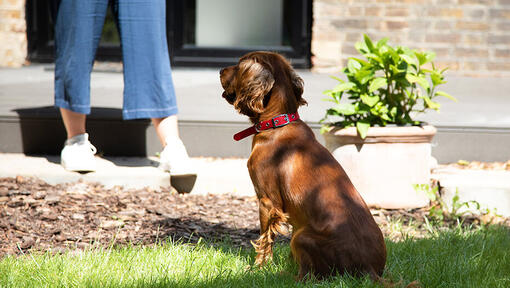
Get your dog used to spending some alone time without ruining furniture or crying help the minute you leave the house. Try these effective dog separation anxiety solutions.
You’re no doubt proud of the unbreakable connection between you and your dog. You’re used to them frantically waggling their tail just because they’re happy to see you. You notice them dutifully following everywhere as if knowing you’re safe is their only life mission. But this close bond needs to be loosened from time to time. You know this. Your dog likely does not. This is why a very mundane night out with friends for you can turn into a dramatic few hours for your dog who doesn’t understand where you’ve gone or whether you will ever come back.
Separation anxiety in dogs is a common problem many dog owners have to learn how to solve. Find out what are the symptoms and how you can help your dog keep calm when you’re not there.
What is separation anxiety in dogs?
Dog separation anxiety is a condition in which dogs show signs of distress when they are left alone. It can affect dogs of all ages and breeds.
What are the symptoms of dog separation anxiety?
You are likely to find out the hard way that your dog is anxious about being left alone - damaged carpets, claw marks on your favourite couch and neighbours telling you about the endless howling sounds your dog subjected them to in your absence.
Unfortunately, some owners think these are just signs of a mischievous dog when in reality their pet is in distress, not knowing how to cope with an empty house.
These are some common signs of separation anxiety in dogs:
- Panting.
- Pacing.
- Attempts to escape the house.
- Damaged furniture.
- Relieving themselves inside the house.
- Barking or howling.
- Extreme excitement when the owners are back.
Why are some dogs experiencing separation anxiety?
Before we get to the dog separation anxiety solutions, it’s useful to look at the causes of distress. These can be varied from early abandonment all the way to genetics.
The most common causes for separation anxiety in dogs include:
- Lack of training.
- Lack of socialisation.
- Fears about elements or events inside or outside the house.
- Changes: new home, new schedule, new family member.
Is it really dog separation anxiety?
Another thing to have in mind before starting any dog anxiety treatment is that you need to make sure their behaviour is correctly identified as a sign of anxiety. That intense barking session while you’re away can be your dog’s reaction to a loud lorry passing by your house. And those chewed window sills might be a sign of acute boredom, not the physical proof of your dog’s separation anxiety.
Unfortunately the problem with telling the difference between the two is that you’re not really there to witness the behaviour. This is why as a first step, it is usually recommended to video your dog when they are alone. If they bark incessantly for the first 10 minutes after you’ve shut the door behind you, it is likely they are indeed experiencing a bout of anxiety. If, on the contrary, they bark every once in a while, go to sleep and then bark some more, it’s more likely they’re just bored and looking for ways to entertain themselves by being a bit noisy.
Dog anxiety treatment
If you’re convinced your dog is in distress and not just restless, it’s time to intervene. Depending on how serious their condition is, these are some of the most common solutions recommended for treating separation anxiety in dogs.
If you love to give your dog proper goodbyes involving drawn-out petting and excessive kisses, consider changing the tactic. All that attention abruptly taken away a few seconds later means your dog will become painfully aware that they are left all alone. Instead, try to make little to no fuss about you leaving or coming back. That entrance door opening or closing should be a normal part of your dog’s life, not an earth-shattering event.
One of the most effective dog anxiety treatments has to do with keeping their mind preoccupied with a task and away from their empty nest. Test a few puzzle toys and choose the ones that take your dog the longest to finish. Give it to them as a task for when you’re gone.
Putting your shoes on or getting the car keys are a sure sign for your dog that you’re about to do the thing they dread the most - vanish out the door. An effective way to keep them calm is to send mixed signals about what these cues mean. For example you can put your shoes on but not leave, get your keys but stay at home or open the door but not go out. This way, your dog won’t start panicking just because you’re heading towards the entrance door or because they hear you jingling the keys.
Find a radio station that broadcasts plenty of talk shows and put it on for your dog to hear while you’re away. Human voices are usually a good solution for dog separation anxiety as it gives them the assurance that they are not completely alone. Some dog owners even record their own voices to help soothe their pooch when they are in distress.
Depending on your dog’s reaction to crate training, this can help treat separation anxiety in dogs. Make sure your dog is okay with being confined to an area and if they give you their go-ahead you can place them in their crate for the duration of your absence. In some cases the crate can become their safe space, an area where they feel comfortable and calm when you are away.
Tips for preventing dog separation anxiety
You don’t have to wait for the separation anxiety in dogs to become a big issue before you take action. Here are a few things you can do to prevent it:
Early training is essential
The earlier you intervene the easier it will be to help your dog get used to some alone time. Ideally this training should take place during puppyhood and our in-depth article about dealing with puppy separation anxiety is a useful resource for this. However if you have an adult dog experiencing separation anxiety you can still start using gradual training. Teach them it is okay to be alone for a minute and then gradually extend the amount of time they are left to their own devices, even if you are still in the house. This way, it will not come as a shock when you leave them alone for the first time.
Exercise
There is no better way to keep your dog calm than to get them tired. This is why exercise is a good prevention tip for dog anxiety. With their energy stores depleted they will be more likely to go take a nap than fight every closed door and window in the house. Use our guide for dog sports and fitness for inspiration on a wide range of dog activities.
Avoid punishments
Don’t punish your dog even if you discover complete mayhem when you return home. As natural as it is to get angry, the deed is done and your dog won’t be able to reverse engineer your punishment and link it to their furniture chewing session from half an hour ago. They will likely think this is what they deserve for welcoming you back and will be even more nervous seeing you leave.
Don’t leave your dog alone for long periods
Lastly, make sure you don’t leave your dog alone for too long. If you need to be away for more than 6 hours and any alternative arrangements have failed (such as taking your dog with you or having friends and family looking after them), you can also consider dog sitting and dog care services.
Is medication necessary for treating separation anxiety in dogs?
Medication can be recommended but only by a vet and for extreme cases of anxiety. Herbal remedies are usually a good first step, but the vet might recommend stronger medication in severe cases. Always seek the advice of your vet before giving your dog any medicines, and never give them tablets or remedies meant for humans.













